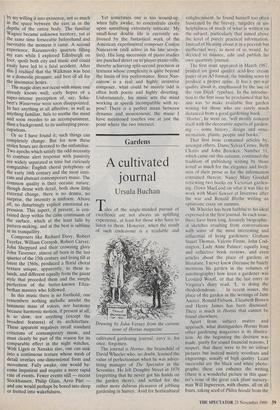Music
Inner vibrations
Robin Holloway
The problem of insomnia has been solved by that ingenious toy the Sony Walkman, The sleepless hours used to be something to dread: too stupefied to work, unwilling even to switch on the light and read, unable to think to any purpose, one would lie there easy prey to compunction for the past and anxiety for the future. The Walkman has changed all this. It can be operated by touch alone, and its most powerful sounds still remain a private secret. What used to be absolutely dead time with no redeeming feature has now become a kind of inner paradise, corres- ponding to nothing in waking life, whose hours are stolen out of the 24 as if in an opiate haze.
I'll never forget my first experience of the Walkman. The closing scene of GOtter- dammerung seemed to be composing itself
by my willing it into existence, not so much in the space between the ears as in the depths of the entire body. The familiar Wagner became unknown territory, yet at the same time forseeable beforehand and inevitable the moment it came. A second experience, Razumovsky quartets filling my ears while I explored Edinburgh on foot, spoilt both city and music and could easily have led to a fatal accident. After this I realised that the Walkman was best as a domestic pleasure; and best of all for the insomniac hours.
The magic does not occur with music one already knows well; early hopes of a super-intense perception of, say, Schu- bert's Winterreise were soon disappointed. In fact anything at all affective, as well as anything familiar, fails to soothe the mind and soon recedes to an accompaniment, then a background, to its unsleeping preoc- cupations.
Or so I have found it; such things can completely change. But for now these stolen hours are devoted to the unfamiliar. Two epochs which satisfy the odd necessity to combine alert response with passivity are widely separated in time but curiously compatible: English choral polyphony of the early 16th century and the most intri- cate and abstract contemporary music. The common quality is their oceanic nature; though dense with detail, both show little external change, there is no drama, no surprise, the intensity is uniform. Above all, no disturbingly explicit emotional ex- pression. This aspect, if present, is con- tained deep within the calm continuum of the surface, which at the least lulls by pattern-making, and at the best is sublime in its tranquillity. Composers like Richard Davy, Robert Fayrfax, William Cornysh, Robert Carver, John Sheppard and their crowning glory John Taverner, almost all born in the last quarter of the 15th century and living till at latest the 1560s, produced a florid choral texture unique, apparently, to these is- lands, and different equally from the gaunt style that preceded them and the simple perfection of the better-known Eliza- bethan masters who followed.
In this music there is no foothold; one remembers nothing melodic amidst the luminous mass of voices, nor harmony because harmonic motion, if present at all, is so slow, nor anything (except the broadest features) of its architecture. These apparent negatives recall standard criticisms of contemporary music, and must clearly be part of the reason for its comparable effect in the night watches. With Ligeti or Xenakis also, one can sink into a continuous texture whose mesh of detail overlies one-dimensional form and movement. Fully awake, one would be- come impatient and require a more rapid rate of events. Fewer events still — recent. Stockhausen, Philip Glass, Arvo Part and one would perhaps be bored into sleep or fretted into wakefulness. Yet sometimes one is too wound-up, when fully awake, to concentrate coolly upon something extremely intricate. My small-hour double life is currently en- livened by the fantastical work of the American experimental composer Conlon Nancarrow (still active in his late seven- ties). His long succession of piano studies are punched direct on to player-piano rolls, thereby achieving split-second precision in textures whose complexity is quite beyond the limits of live performance. Since Nan- carrow is a real and highly inventive composer, what could be merely odd is often both poetic and highly diverting. Unfortunately, his music sets the mind working at speeds incompatible with re- pose! There is a perfect mean between dynamic and monotonous; the music I have mentioned touches one at just the point where the two intersect.











































































 Previous page
Previous page